
Original Link: https://www.anandtech.com/show/1831
F.E.A.R. GPU Performance Tests: Setting a New Standard
by Josh Venning on October 20, 2005 9:00 AM EST- Posted in
- GPUs
Introduction
We have been excited about lots of new games being released and we've had our hands full testing and playing as many as we can. Starting with games like Battlefield 2, we've been seeing some big advancement in game graphics even within the past few months. Black and White 2, in particular, impressed us recently with its amazing images of water and overall environments. We are always excited about a game that has beautiful looking graphics and rich gameplay as well, and it seems like this is happening more often lately, much to our delight. The Call of Duty 2 demo also has us all giddy, and it looks and plays great, even if it is frustratingly short.
Some other games that have us waiting in anticipation are Quake 4 and Age of Empires 3. We wish that we had some good demos of these games, but unfortunately we have to wait for the release date like everyone else. It seems like the bar is being raised higher and higher with new games in terms of graphics that video card manufacturers might have trouble keeping up, and this past Tuesday, with the release of FEAR, the bar was raised a very significant notch. Yes, FEAR is out, and it is beautiful.
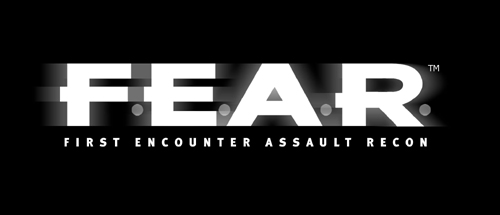
While the single and multiplayer demos of this game have been available for quite some time, we had the (quite correct) understanding that final performance would not look anything like what the demo showed. Today, readers can rest assured that the numbers that we have collected will be an accurate reflection of FEAR performance on modern hardware.
The Game/Test setup
There was a lot of hype about FEAR before it was released, which is common for ground-breaking games of this sort. Too much hype can be a bad thing as we've seen before with other games, and while it may have some similarities to the movies, we aren't quite willing to put FEAR on the same level as The Ring and The Matrix, in spite of the dramatic slow motion deaths and the scary looking little girl.
In this case, though, FEAR more or less lives up to the hype, and what we have here is possibly the most beautiful looking, first-person shooter that we've ever seen. The dark and moody atmosphere and lighting are nice, reminiscent of Doom 3 except that you can actually see most of the time. During heated action sequences, the combination of lighting effects from things like muzzle flashes and sparks from bullet ricochets, as well as dust that falls from wall shots creating hazy clouds create a beautiful scene of chaos. This is further enhanced by the much-copied (but still fun) bullet-time/reflex mode, which slows everything down so that the chaos of sparks, dust and bodies flying through the air resemble some bizarre ballet that will occasionally make you pause to marvel at its beauty. Other graphical elements worth mentioning are the fire effects, which are impressive, compared to most other games, as are the water effects (reflections, ripples and caustics).
To be fair, a few things could have looked better in the game. While the levels are pretty, they can be repetitive, as can the enemies, which are mostly hordes of a few different variations of clone soldiers, and the effectiveness of the games parallax mapped environment damage is not up to snuff. These are just a few complaints, however, and graphically, the good stuff more than outweighs the bad. Further more, because the enemy AI is so smart and action so intense, you'll be so caught up in gameplay that the small graphical problems won't matter much.
Not only is this the best looking game out right now, but it also happens to be the most graphically demanding, as we will see in our performance tests. It's so demanding in fact that it could be a good reason for people to upgrade their graphics card. FEAR only supports resolutions of up to 1600x1200, but only the highest end cards can handle this resolution well, especially with soft shadows and/or AA enabled. In fact, this may be the first game that puts the 7800 GTX to its full use, as our tests showed at 1600x1200 with soft shadows and AA enabled FEAR was barely playable.
We wanted to get an idea about how FEAR performs across a wide range of graphics cards, so we tested a good sample of high end and mid-range cards. These are the kind of cards that we could see paired with our high end test system.
NVIDIA GeForce 7800 GTX
NVIDIA GeForce 7800 GT
NVIDIA GeForce 6800 GT
NVIDIA GeForce 6600 GT
ATI Radeon X1800 XT (not yet available)
ATI Radeon X1800 XL
ATI Radeon X1600 XT (not yet available)
ATI Radeon X1300 Pro
ATI Radeon X800 GT
We also tested all resolutions possible up to 1600x1200, the highest that FEAR will run, with and without 4xAA and 8xAF enabled. FEAR gives the option to turn on a feature called soft shadows, which we will talk about later, and because of some issues that we saw with this, we ran benchmarks with and without this enabled. All other options were turned up to their maximum quality level. For those of you with older mid-range and lower end cards, maximal detail is not really an option at any resolution.
This is our test system:
NVIDIA nForce 4 motherboard
AMD Athlon 64 FX-55 2.6 GHz Processor
1 GB OCZ 2:2:2:6 DDR400 RAM
Seagate 7200.7 120 GB Hard Drive
OCZ 600 W PowerStream Power Supply
We also made sure to test with sound disabled. This test isn't as strict a test of graphics performance as some of our other benchmarks. For one, we used the built-in test feature. While this gives us a consistent "run" through a scene, physics variability and slight differences in what the characters in the scene do are apparent. This is similar to the Far Cry test if Crytek had added physics cues to the camera path of their benchmark.
While we would like to see more consistent action in order to compare cards better, the built-in tool is a much better option than using fraps while running through a level. As mentioned, we tested three different game settings. Driver settings were all default except for VSYNC, which was explicitly disabled.
Before we get to the numbers, let's take a deeper look at some of the graphics and performance issues that we noted previously.
The Failure of Soft Shadows and Parallax Mapping
Soft Shadows
We've seen how soft shadows can be used effectively in games like The Chronicles of Riddick, and Monolith has decided to add this as an option in FEAR. Used correctly, soft shadows greatly enhance lighting in a game by giving shadows cast by objects different levels of darkness making them more realistic. This process can take up a lot of processing power however, and that's no exception for FEAR.
Basically, soft shadows are an effect that show how shadows tend to fade at the edges or cast overlapping lines on walls or objects depending on different factors such as light angle and distance. If you've ever made a shadow-puppet, you can see this clearly, as multiple outlines of your hand shadow overlap on the wall with varying degrees of darkness (depending on the light source). And if you were to move your hand closer or farther away from the light, you can see how the soft shadows change dynamically.
The idea is to capture this effect in a game environment, but as any programmer would know, translating this to a game engine can be a very complex undertaking. Not only that, but as we mentioned before, calculating multiple shadows in real time can quickly become a major leech of processing power. With FEAR, we've seen how big of a performance hit that we had when we enabled soft shadows, but you may wonder, "does the effect at least look good?"
The short answer is "no". The way that FEAR incorporates soft shadows ends up looking unrealistic; more stratified and strange than soft. It simply looks as though the game draws multiple shadows at the edges of objects and offsets them up, down, left and right very slightly at different degrees of darkness regardless of the light source. This wouldn't be so bad if the multiple shadows were not readily noticeable as such. It also would have been nice if the "blur factor" were more dynamic; in other words, moving the shadows closer together or farther apart given where the object (say an enemy soldier) is in relation to the light sources and shadowed surfaces.
This is difficult to understand until you see it happening in the game, but you can get a better idea of it by looking at a few pictures. We took some screen shots of a scene with and without soft shadows enabled with both NVIDIA and ATI cards. Please ignore the slight lighting and position differences of these screens.
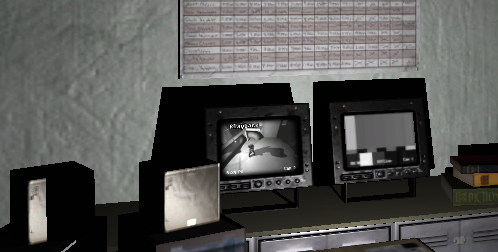
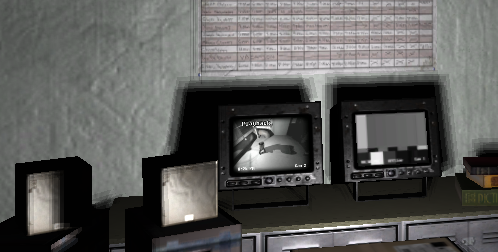
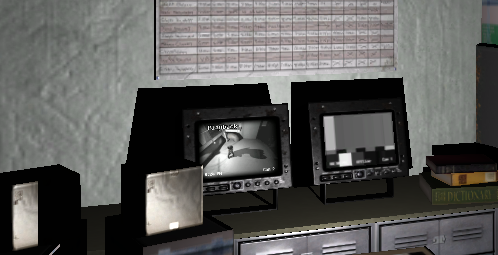
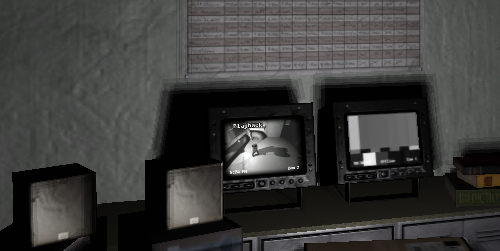
Parallax Mapping
While the detailed textures, excellent lighting, well done static and dynamic shadows (in spite of the soft shadow issue), large intricate particle systems, and various beautiful effects of FEAR come together to form an immersive and fluid graphical experience, there are a few caveats. To their credit, Monolith was very aggressive with the features that they included and are on the leading edge of technology. The use of a deep parallax mapping algorithm to represent damage is a very cool idea, but the implementation used in FEAR doesn't include key features such as self-occlusion and self-shadowing. When passing a wall with a chunk blown out, the hole will swim around, flatten out, and eventually look like unidentifiable goo stuck to the wall as the angle gets very steep.
The parallax mapping used looks great from angles where the entire interior of a hole can be seen. The problem occurs at viewing angles where a near edge would need to block the view of part of (or the entire) interior of the indention. Rather than occluding anything, parts of the texture that should become invisible are still shown (albeit distorted). This completely destroys the illusion of depth at steep angles by making the texture kind of swim until it totally loses its three-dimensionality. There are algorithms available that can represent correctly self-occlusion in parallax mapping. While we can appreciate cheaper parallax mapping algorithms as a kind of upgraded bump mapping, dramatic surface deformation should either be done more correctly or not at all in cases where the viewer can move to angles that break the effect.
But again, we would love to give credit where credit is due. We would rather see game developers experiment with new technology and put something out there than let the true power of our graphics cards remain dormant. Monolith was ahead of the curve with the graphics in Tron 2.0, and they haven't let us down with the quality of FEAR.
No Soft Shadows and No AA/AF Performance Tests
This is the setting that we would recommend most people establish. Anisotropic filtering can be enabled for a minimal performance drop, but many people just won't have hardware that can handle soft shadows or antialiasing. Also note that we have made quite a big deal about the fact that soft shadows in this game just aren't worth it.
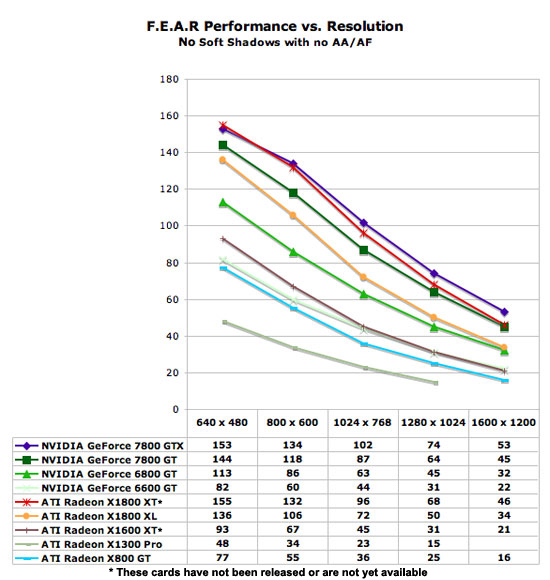
Without soft shadows or AA enabled, you can see that until you get to a resolution as high as about 1024x768, all of these cards get playable framerates. The X1300 Pro is the most limited of these cards and can really only play this game well at 640x480 and 800x600 without AA or soft shadows enabled. But you can see how low the framerates are in general at 1280x1024 and 1600x1200 for all the cards, giving us a first look at the graphical demands of this game. The 7800 GTX and 7800 GT get very respectable framerates at 1600x1200 though, and at this same resolution, the 6800 GT and X1800 XL are low, but still playable. 25 fps is about as low as we would consider barely "playable", but to really enjoy the gameplay, you'll want a framerate of about 35 fps. Now, let's look at what happens when we turn on 4xAA and 8xAF.
4xAA/8xAF Performance Tests
This is a good option for gamers with a high end card. Generally, the best way to get a better experience from a game is going to be increasing resolution. This is especially true of FEAR because the performance hit of enabling 4xAA is incredibly large. Much of FEAR is designed well to avoid noticeable aliasing (low contrast edges), and the most noticeable edges in the game are high contrast shadows.
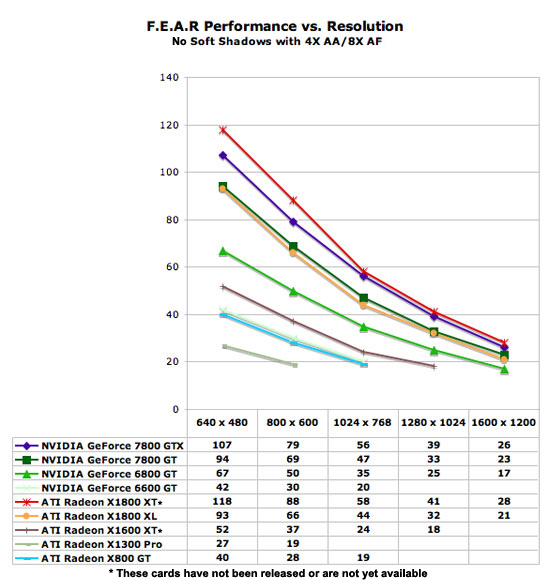
Soft Shadows Performance
Please refer back to our earlier section on soft shadows to learn why (aside from abysmal performance) we recommend against enabling soft shadows. Upon selecting the option in FEAR to enable soft shadows, a dialog box will pop up to inform the gamer that soft shadows are a high end option, which will only run well on heavy hitting graphics hardware. It is very true that you need to high end hardware to run the game with soft shadows, but we just don't like the feature.

Final Words
As we said in our introduction, FEAR does indeed set a new standard for games, and there is no denying the quality of its graphics. Perhaps there could have been more variety in some areas, but the beauty of the action sequences can't be matched in any first-person shooter that we've seen. For graphics, FEAR paves the way for a new generation of games, and is also the first game able to bring the highest powered cards available to their knees when played at its full graphical potential.
We feel that it is important to note that we tested with products unavailable at this time. We feel that it is important to look forward at what we might be able to expect from ATI in terms of performance. At the same time, we feel that that gap between launch and availability of product at this point in the game is a huge mistake. All we need to say about the subject is that there is no reason to wait for these cards to become available based on our performance analysis.
This game alone gives players without high end monitors a real reason to justify saving up for a 7800 GTX. Those who want to play FEAR at the highest resolution and settings with AA enabled (without soft shadows) will basically have to use the 7800 GTX, as no other card available gets playable framerates at those settings, and the 7800 GTX does just barely (if uncomfortably). If you have to play at 1600x1200 and you don't care about AA, then the 7800 GT and possibly the 6800 GT will play well, as will ATI's X1800 XL. However, don't run out and buy an X1800 XL just yet because the 7800 GT runs the game better, and right now, you can buy the NVIDIA darling for less money than the X1800 XL (about $340 as opposed to $390).
FEAR looks good enough that people will enjoy the game at even the lowest resolutions, and all of the cards that we've tested will run the game fine at resolutions as high as 1024x768 without AA and soft shadows, with the exception of the X1300 PRO. This card performed the worst overall, but it still runs FEAR fine (without AA and SS) at 800x600. If you are on a shoestring budget, but need to buy one of these cards to play FEAR, a good choice would be the X800 GT for $130, or even better, the 6600 GT for about $15 more. That's not much more money considering the 6600 GT gets 31 fps at 1280x1024 compared to only 25 fps on the X800 GT, which we wouldn't waste our time. With the MSRP on the X1300 Pro sitting at about $150, we can't see how the part will sell at all given its competition.
If you are looking for a good middle-of-the-road card that could handle 1024x768 with AA enabled, the 6800 GT might be a good choice, but at $280, it might be nice to save up and get the 7800 GT ($340). Overall though, given performance and price, you'll want to stay away from both the X1800 XL and the X1300 PRO, as they just aren't practical. Keep in mind, however, that these are still very new graphics cards and prices change.
This is very old news by now, but we have to mention it yet again. The fact that ATI still has no competitor for the 7800 GTX yet means that lots of FEAR players will be looking to NVIDIA for their graphics solution. This puts ATI behind again, and with games like Quake 4 coming out soon, things are looking even worse for ATI than they already have been. We were happy to see that ATI is at least coming out with high end parts, but where is the 7800 GTX competition? We need to see the X1800 XT on shelves with a competitive price soon, or there won't be much that can help ATI, especially with the rumors about what's coming down the pipe from NVIDIA.
All that aside, our focus here is on FEAR, and while we aren't saying that this is the best game out now by any means, we are saying that it is probably the most significant, given how graphically demanding it is. Be assured that we will be giving it a much more thorough testing on the "fun-ness" factor for a while to come.







